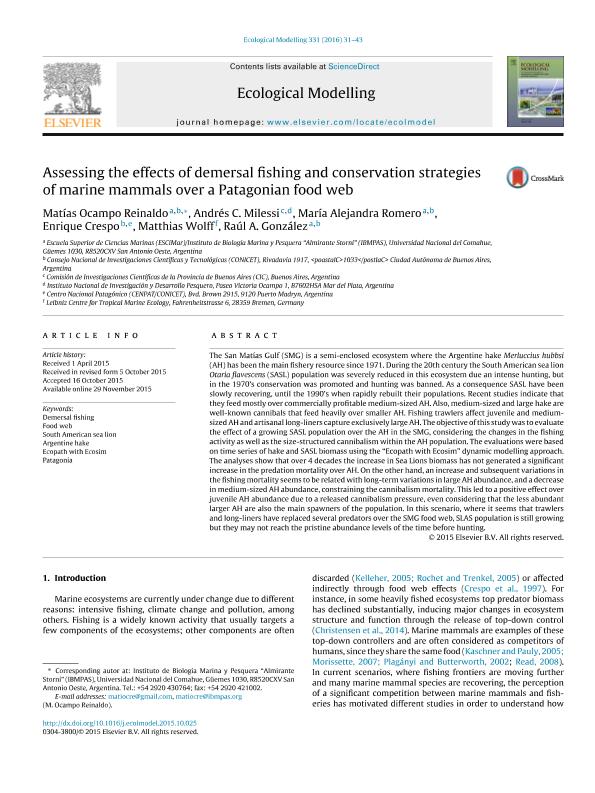Mostrar el registro sencillo del ítem
dc.contributor.author
Ocampo Reinaldo, Matías

dc.contributor.author
Milessi Millan, Andres Conrado

dc.contributor.author
Romero, Maria Alejandra

dc.contributor.author
Crespo, Enrique Alberto

dc.contributor.author
Wolff, Matthias
dc.contributor.author
González, Raul Alberto Candido

dc.date.available
2018-03-19T16:46:33Z
dc.date.issued
2016-07-10
dc.identifier.citation
Ocampo Reinaldo, Matías; Milessi Millan, Andres Conrado; Romero, Maria Alejandra; Crespo, Enrique Alberto; Wolff, Matthias; et al.; Assessing the effects of demersal fishing and conservation strategies of marine mammals over a Patagonian food web; Elsevier Science; Ecological Modelling; 331; 10-7-2016; 31-43
dc.identifier.issn
0304-3800
dc.identifier.uri
http://hdl.handle.net/11336/39210
dc.description.abstract
The San Matías Gulf (SMG) is a semi-enclosed ecosystem where the Argentine hake Merluccius hubbsi (AH) has been the main fishery resource since 1971. During the 20th century the South American sea lion Otaria flavescens (SASL) population was severely reduced in this ecosystem due an intense hunting, but in the 1970's conservation was promoted and hunting was banned. As a consequence SASL have been slowly recovering, until the 1990's when rapidly rebuilt their populations. Recent studies indicate that they feed mostly over commercially profitable medium-sized AH. Also, medium-sized and large hake are well-known cannibals that feed heavily over smaller AH. Fishing trawlers affect juvenile and medium-sized AH and artisanal long-liners capture exclusively large AH. The objective of this study was to evaluate the effect of a growing SASL population over the AH in the SMG, considering the changes in the fishing activity as well as the size-structured cannibalism within the AH population. The evaluations were based on time series of hake and SASL biomass using the "Ecopath with Ecosim" dynamic modelling approach. The analyses show that over 4 decades the increase in Sea Lions biomass has not generated a significant increase in the predation mortality over AH. On the other hand, an increase and subsequent variations in the fishing mortality seems to be related with long-term variations in large AH abundance, and a decrease in medium-sized AH abundance, constraining the cannibalism mortality. This led to a positive effect over juvenile AH abundance due to a released cannibalism pressure, even considering that the less abundant larger AH are also the main spawners of the population. In this scenario, where it seems that trawlers and long-liners have replaced several predators over the SMG food web, SLAS population is still growing but they may not reach the pristine abundance levels of the time before hunting.
dc.format
application/pdf
dc.language.iso
eng
dc.publisher
Elsevier Science

dc.rights
info:eu-repo/semantics/openAccess
dc.rights.uri
https://creativecommons.org/licenses/by-nc-sa/2.5/ar/
dc.subject
Argentine Hake
dc.subject
Demersal Fishing
dc.subject
Ecopath with Ecosim
dc.subject
Food Web
dc.subject
Patagonia
dc.subject
South American Sea Lion
dc.subject.classification
Otras Ciencias Biológicas

dc.subject.classification
Ciencias Biológicas

dc.subject.classification
CIENCIAS NATURALES Y EXACTAS

dc.subject.classification
Otras Ciencias Biológicas

dc.subject.classification
Ciencias Biológicas

dc.subject.classification
CIENCIAS NATURALES Y EXACTAS

dc.title
Assessing the effects of demersal fishing and conservation strategies of marine mammals over a Patagonian food web
dc.type
info:eu-repo/semantics/article
dc.type
info:ar-repo/semantics/artículo
dc.type
info:eu-repo/semantics/publishedVersion
dc.date.updated
2018-03-02T15:01:25Z
dc.journal.volume
331
dc.journal.pagination
31-43
dc.journal.pais
Países Bajos

dc.journal.ciudad
Amsterdam
dc.description.fil
Fil: Ocampo Reinaldo, Matías. Universidad Nacional del Comahue. Centro de Investigacion Aplicada y Transferencia Tecnologica En Recursos Marinos "almirante Storni". - Provincia de Rio Negro. Ministerio de Agricultura, Ganaderia y Pesca. Centro de Investigacion Aplicada y Transferencia Tecnologica En Recursos Marinos "almirante Storni". - Consejo Nacional de Investigaciones Cientificas y Tecnicas. Centro Cientifico Tecnologico Conicet - Centro Nacional Patagonico. Centro de Investigacion Aplicada y Transferencia Tecnologica En Recursos Marinos "almirante Storni". ; Argentina; Argentina
dc.description.fil
Fil: Milessi Millan, Andres Conrado. Provincia de Buenos Aires. Gobernación. Comisión de Investigaciones Científicas; Argentina. Consejo Nacional de Investigaciones Científicas y Técnicas. Centro Científico Tecnológico - CONICET - Mar del Plata. Instituto de Investigaciones Marinas y Costeras. Subsede Instituto Nacional de Investigación y Desarrollo; Argentina
dc.description.fil
Fil: Romero, Maria Alejandra. Universidad Nacional del Comahue. Centro de Investigacion Aplicada y Transferencia Tecnologica En Recursos Marinos "almirante Storni". - Provincia de Rio Negro. Ministerio de Agricultura, Ganaderia y Pesca. Centro de Investigacion Aplicada y Transferencia Tecnologica En Recursos Marinos "almirante Storni". - Consejo Nacional de Investigaciones Cientificas y Tecnicas. Centro Cientifico Tecnologico Conicet - Centro Nacional Patagonico. Centro de Investigacion Aplicada y Transferencia Tecnologica En Recursos Marinos "almirante Storni". ; Argentina; Argentina
dc.description.fil
Fil: Crespo, Enrique Alberto. Consejo Nacional de Investigaciones Científicas y Técnicas. Centro Nacional Patagónico; Argentina
dc.description.fil
Fil: Wolff, Matthias. Leibniz Centre for Tropical Marine Ecology; Alemania
dc.description.fil
Fil: González, Raul Alberto Candido. Universidad Nacional del Comahue. Centro de Investigacion Aplicada y Transferencia Tecnologica En Recursos Marinos "almirante Storni". - Provincia de Rio Negro. Ministerio de Agricultura, Ganaderia y Pesca. Centro de Investigacion Aplicada y Transferencia Tecnologica En Recursos Marinos "almirante Storni". - Consejo Nacional de Investigaciones Cientificas y Tecnicas. Centro Cientifico Tecnologico Conicet - Centro Nacional Patagonico. Centro de Investigacion Aplicada y Transferencia Tecnologica En Recursos Marinos "almirante Storni". ; Argentina; Argentina
dc.journal.title
Ecological Modelling

dc.relation.alternativeid
info:eu-repo/semantics/altIdentifier/doi/http://dx.doi.org/10.1016/j.ecolmodel.2015.10.025
dc.relation.alternativeid
info:eu-repo/semantics/altIdentifier/url/https://www.sciencedirect.com/science/article/pii/S0304380015005104
Archivos asociados
